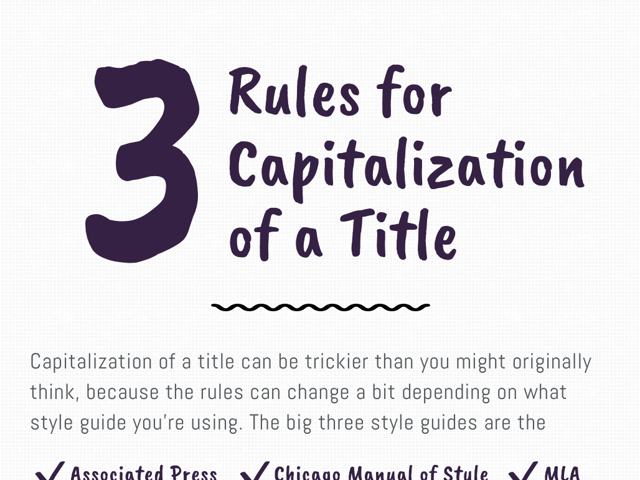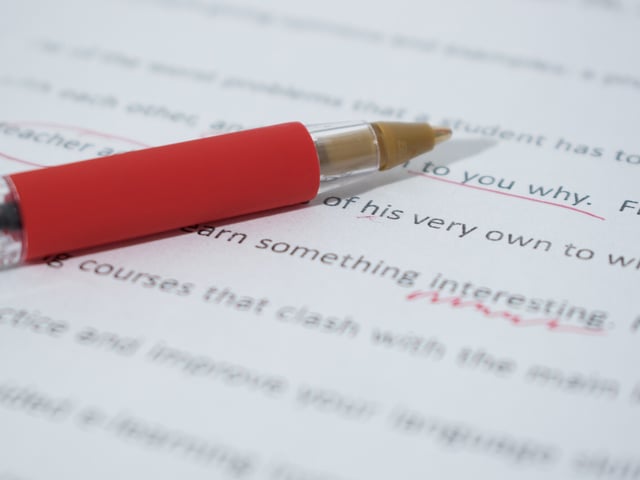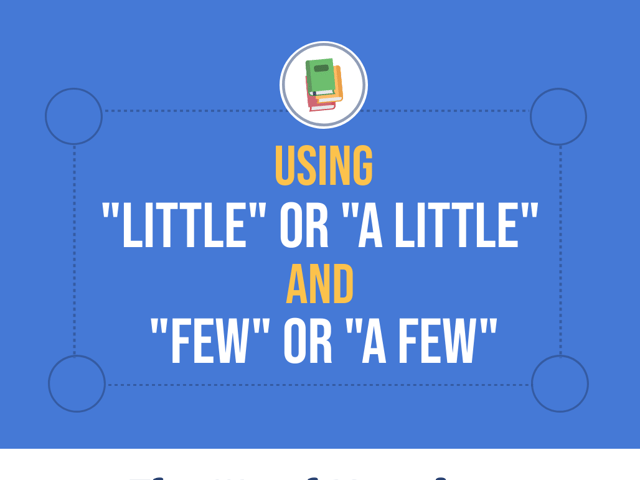
Capitalization of a Title
Capitalization of a title can be trickier than you might originally think, because the rules can change a bit depending on what style guide you’re using. The big three style guides are the Associated Press, often called AP for short, Chicago Manual of Style, and MLA. You might be required to use a specific style in a certain setting or institution, so if you’re writing something important (say like a college thesis) always be sure to check.
Why Is Title Capitalization Important?
Title capitalization is more than just a formality; it plays a crucial role in setting readers’ expectations and conveying the essence of the content that follows. Let’s delve deeper into its significance:
Establishes Consistency
Creates Visual Cohesiveness: Uniform capitalization provides a consistent visual appeal across different content types. Whether readers are skimming through a magazine, browsing a blog, or perusing a research paper, consistent title capitalization makes it easier to identify main topics.
Reflects Professionalism: Consistent title capitalization indicates attention to detail, which can be seen as a mark of professionalism and thoroughness. A publication that maintains consistent capitalization can often be perceived as more credible.
Sets the Tone
Indicates Content Quality: First impressions matter. A properly capitalized title often gives an immediate impression of quality. On the contrary, a title with erratic or incorrect capitalization may be seen as careless, reflecting negatively on the author or publisher.
Builds Trust: When a title is meticulously crafted, it can signify that the content has been curated with the same level of care. This can help in building trust with the readers, making them more likely to engage with the content and view the author or publication as authoritative.
Aids in Understanding
Highlights Key Concepts: Capitalization serves to spotlight the main ideas or themes of the content. By emphasizing certain words, readers can quickly gauge the crux of the article or story, aiding in comprehension.
Guides Readers: Especially in longer titles or those with multiple clauses, capitalization helps in breaking down the title into digestible bits, guiding readers through the primary and secondary ideas, and setting the stage for what to expect in the subsequent content.
Differentiates Titles from Content: Proper title capitalization also helps in distinguishing titles from the rest of the content, ensuring that they are immediately recognizable, especially in platforms where design elements like font sizes might not vary significantly.
Capitalization Rules
When crafting titles, understanding capitalization rules ensures your content is presented professionally and adheres to standard conventions. Here’s a breakdown of these rules:
First and Last Word
In titles of books, songs, movies, or any other written works, the first and last words are always capitalized regardless of their part of speech. Consider the movie title Night at the Museum; both “Night” and “Museum” are capitalized even though “at” and “the” are not.
Capitalize Main Words
All principal words in a title, including nouns, verbs, pronouns, adjectives, and adverbs, should be capitalized. In the movie title I Walk the Line, the word “Walk” is capitalized because it is a verb. In Drive, He Said, the word “He” is capitalized as it’s a pronoun. And, “Grouchy” in the children’s book title The Grouchy Ladybug is an adjective and is therefore capitalized.
Avoid Capitalizing Certain Small Words
Articles (a, an, the), prepositions with less than five letters (of, in, to, for, etc.), and coordinating conjunctions (and, but, or, nor, for, so, yet) are typically not capitalized in a title unless they are the first word.
For instance, in Good Night, and Good Luck, the conjunction “and” remains lowercase. Similarly, “of” in the song title Angel of the Morning is in lowercase. However, if they start the title, as in An Affair to Remember, they should be capitalized.
In the title Chasing the Winds of Change, the words “the” and “of” are kept lowercase due to their roles as an article and a short preposition, respectively.
The novel Of Mice and Men capitalizes “Of” since it begins the title, but leaves the conjunction “and” in lowercase.
Subordinate Conjunctions and Longer Prepositions
When prepositions turn five letters or more (underneath, between, through, etc.) or when you’re dealing with subordinate conjunctions (although, because, since, etc.), they should be capitalized in titles. For example, in the title Dancing Underneath the Stars, the word “Underneath” is capitalized.
Capitalize Hyphenated Compound Words
For titles with hyphenated compound words, each part should be capitalized. For example, in the title “Mother-in-Law’s Secret Recipe,” both “Mother” and “Law” are capitalized.
In the book title Self-Reflection in Modern Times, both “Self” and “Reflection” are capitalized due to the hyphenation.
The award-winning film Spider-Man: Into the Spider-Verse capitalizes both “Spider” and “Man,” adhering to the hyphenated compound word rule.
By following these capitalization rules, you ensure that your titles are not only grammatically correct but also look professional and polished. Always double-check your titles against these guidelines, and when in doubt, consult a style guide pertinent to your writing context.
Differences Between Style Guides
Title capitalization rules may seem straightforward at first glance, but the devil is often in the details. Different style guides can have varying rules, leading to subtle yet impactful differences in the presentation of titles. Understanding these nuances is essential for writers, especially when switching between different formats or publishing platforms.
AP (Associated Press) Style
The AP style is a go-to for many journalists and news outlets. One of its distinguishing features is its straightforward approach to capitalization:
-
Words with four letters or more are always capitalized.
-
Short prepositions, articles, or conjunctions are typically left in lowercase unless they’re at the beginning or end of the title. This means that in a title like “On the Edge of Tomorrow,” both “On” and “Tomorrow” would be capitalized, but “the” and “of” would not.
Chicago Manual of Style
The Chicago style, often used in book publishing and some academic papers, is a bit more intricate:
-
Prepositions, regardless of their length, are capitalized if they’re used in a substantive, adjectival, or adverbial manner. For example, in a title like “Running Through the Rain,” “Through” would be capitalized.
-
An interesting quirk of the Chicago style is its approach to infinitives. The “to” in infinitives, as in “To Be or Not To Be,” is kept lowercase.
MLA (Modern Language Association) Style
Widely adopted in academic circles, especially in the humanities, the MLA style has its unique features:
-
Emphasis is placed on capitalizing the first, last, and all principal words in a title. This means that in a title like “Between the Mountains and the Sea,” both “Between” and “Sea” are capitalized, along with “Mountains.”
-
However, similar to AP style, it does not capitalize articles, short prepositions, or conjunctions unless they start or end the title.
Common Pitfalls and How to Avoid Them
Navigating the intricate world of title capitalization can be daunting, especially given the differences across style guides. Mistakes are easy to make, but with awareness and diligence, they can be sidestepped. Here’s a closer look at some common pitfalls and strategies to avoid them:
Not Knowing Your Style Guide
Different style guides cater to various writing purposes. For instance, while AP style is common for journalism, MLA might be the preferred choice for academic writing in the humanities. Using the wrong style can lead to inconsistencies and might even affect the credibility of your content.
Before you begin writing, always clarify the required style guide, especially if you’re writing for a new publication, institution, or academic course. If in doubt, reach out to an editor or supervisor for confirmation. Familiarize yourself with the nuances of that particular style to ensure consistency throughout your piece.
Over Capitalizing
An overly capitalized title can appear jarring and might give the impression of shouting or exaggeration. Moreover, unnecessary capitalization can detract from the main focus of the title.
Keep in mind the basic principles of title capitalization, such as capitalizing the first and last words and all major words in between. When uncertain, consult your style guide. Remember, capitalization is not a tool for added emphasis; let the words and content provide the impact.
Relying on Automated Tools
Automated tools, while convenient, are not infallible. They might not always align with specific style guide nuances or might overlook certain capitalization rules. Relying solely on them can lead to overlooked errors.
While it’s okay to use automated tools as a starting point or for a preliminary check, always do a manual review afterward. Become proficient in the style guide you’re using so you can spot inconsistencies the tool might miss. For crucial documents or publications, consider seeking a second pair of eyes—an editor or a peer—to ensure accuracy.
In summary, while title capitalization can seem like a minor detail, it plays a significant role in presenting polished and professional content. By being aware of common pitfalls and actively taking steps to avoid them, you can ensure that your titles are always on point.

Keep Reading

English Basics Blog
How to Write a Compare and Contrast Essay
When you were in school, you probably had to write a lot of different t…

English Basics Blog
What are Superlatives?
We spend our lives making comparisons, whether we realize it or not. Wh…

English Basics Blog
When to Use “Little” or “a Little” and “Few” or “a Few”
Few aspects of the English language can grow as convoluted as when to u…